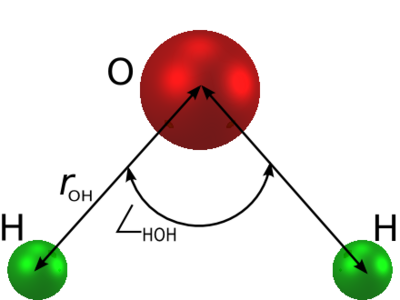SPC model of water: Difference between revisions
Jump to navigation
Jump to search
Carl McBride (talk | contribs) m (Added book ISBN) |
Carl McBride (talk | contribs) m (Changed a reference to cite format) |
||
| Line 24: | Line 24: | ||
==Surface tension== | ==Surface tension== | ||
The [[surface tension]] has been studied for the SPC model by Vega and Miguel. | The [[surface tension]] has been studied for the SPC model by Vega and Miguel. | ||
<ref>[http://dx.doi.org/10.1063/1.2715577 C. Vega and E. de Miguel "Surface tension of the most popular models of water by using the test-area simulation method", Journal of Chemical Physics '''126''' 154707 (2007)]</ref> | |||
==Related models== | ==Related models== | ||
Over the years a number of variants of the SPC model have been published: | Over the years a number of variants of the SPC model have been published: | ||
Revision as of 16:19, 19 November 2010
The simple point charge (SPC) model [1] is an empirical model of water. The molecule is modelled as a rigid isosceles triangle, having charges situated on each of the three atoms. As well as Coulombic interactions, the molecules interact via long-range Lennard-Jones sites, situated on the oxygen atoms. The parameters are as follows:

| parameter | value |
| kJ mol-1 | |
| (charge neutrality) |
The SPC model has a dipole moment of 2.27 D.
Surface tension
The surface tension has been studied for the SPC model by Vega and Miguel. [2]
Related models
Over the years a number of variants of the SPC model have been published:
References
- ↑ H. J. C. Berendsen, J. P. M. Postma, W. F. van Gunsteren and J. Hermans, in: Intermolecular Forces (B. Pullman, ed.), Reidel, Dordrecht (1981) p. 331 ISBN 902771326X
- ↑ C. Vega and E. de Miguel "Surface tension of the most popular models of water by using the test-area simulation method", Journal of Chemical Physics 126 154707 (2007)











